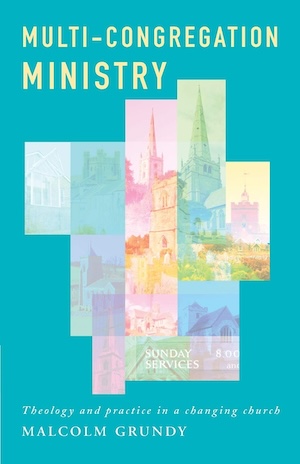Many church ministers today find themselves leading multiple congregations, especially within the established denominations in England. It is therefore quite surprising that there are no obvious ‘must read’ books on this kind of leadership.
So far, I have read two book(let)s on the topic (click on the links to read my reviews). In Leading One Church at a Time: From Multi-church Ministers to Focal Ministers (2018), Bob Jackson emphasises how beneficial it is for each church to have a recognised minister (lay or ordained) to work with and under the minister with formal oversight. In Thrive: Helping Your Multi-Parish Benefice to Grow (2023), Pam Macnaughton invites a small team from the group of churches to embark on a journey together, developing relationships and exploring various dimensions in the life of the churches.
2015 saw the publication of Malcolm Grundy’s book, Multi-Congregation Ministry: Theology and Practice in a Changing Church. The back cover describes the author in glowing terms:
Malcolm Grundy is a consultant, writer and trainer with wide experience of the church’s ministry. He was formerly Senior Chaplain of the Sheffield Industrial Mission, Director of Training in the Diocese of London, Archdeacon of Craven in the Diocese of Bradford, co-founder of the Edward King Institute for Ministry Development and Chair of MODEM. His final post before retirement was as the first Director of the Foundation for Church Leadership. He has written several books on the church’s ministry and is now a Visiting Fellow at York St John University.
With a biography like that, and with such an extensive bibliography, the book is bound to contain valuable insights.
However, here, almost at random, is a sampling of the style of the book:
The personality, leadership style and effectiveness of any individual or group will depend ultimately on the stage of development or decline of the organization, whether company, charity or church, to which they belong (p. 76).
Thus the expansion of my oversight model with its three essential characteristics reinforces the practical evidence which formed the original concept of modelling (p. 109).
Moreover, the chapter headings and subheadings often bear little relation to the text that follows.
The basic shape of the book is ‘description followed by theology followed by practice’ (viii).
Chapter 1 helpfully names some of the changes and challenges brought about by a shift to multi-congregation ministry. For example, there is often a sense of loss, many responsibilities need to be delegated, it is difficult to shape the direction of a church if you are not physically present, communication is a challenge, and it is difficult to remain outward-facing (pp. 6-12). There are also changes in the relationship between a congregation and its denomination.
In response, Grundy calls for a more collaborative understanding of oversight, in a key phrase that returns throughout the book: ‘watching over one another in community’ (e.g., p. 27).
Chapter 2 continues to describe the situation with a closer look at different configurations of multi-congregation ministry.
Chapter 3 moves to theology (and the wider Christian tradition), looking at historical and ecumenical perspectives on oversight. Drawing on the ecumenical document from 1982, Baptism, Eucharist and Ministry, the church is characterised by koinonia, apostolicity and unity, and the oversight of the church needs to be personal, collegial and communal.
Chapter 4 draws on numerous sources (including secular sources) in order to identify the key aspects of oversight. Metaphors and images are grouped together under three headings, which capture the different dimensions of oversight: organic, directional and authoritative.
Chapter 5 moves towards practice, and contains (as anticipated) numerous helpful hints for leadership. (The style is more accessible too.) However, I counted only four passing references to multi-congregation ministry. The basic message thus far seems to be: multi-congregation ministry is complicated, but it will help if you grow in character and wisdom as a leader.
Chapter 6 begins with a recap of the book, and then highlights some of the benefits that come when churches work well together. (This might or might not be associated with multi-congregation ministry.) This is followed by some reflections on the changing vocations:
- of congregations: towards interdependence
- of ministers: towards a greater variety of roles
- of denominations: towards shared oversight
There is much food for thought in this book, but there is little in terms of practical advice for multi-congregation ministry, and the connections between the theoretical and practical parts of the book are very thin (despite repeated claims to the contrary).
What would I like to see in a book about multi-congregation ministry? At least some of the following:
- Case studies illustrating growth
- Being present in multiple communities
- Balancing doing ministry with resourcing others in their ministry
- Allocating time, transparency and accountability
- Helping churches to come together for the first time, grieving, looking to the future with hope, making difficult decisions as a group of churches
- Working well together, taking account of geography, demographics, culture, church size and tradition
- Service times, rotas, preaching teams
- Shared or collaborative governance and oversight
- Mission and discipleship
- Buildings and finances
- Use of technology
Do let me know if such a book exists!
